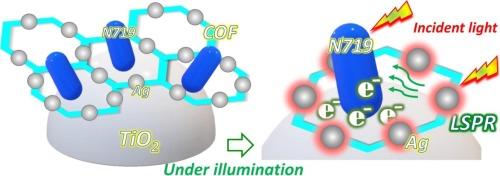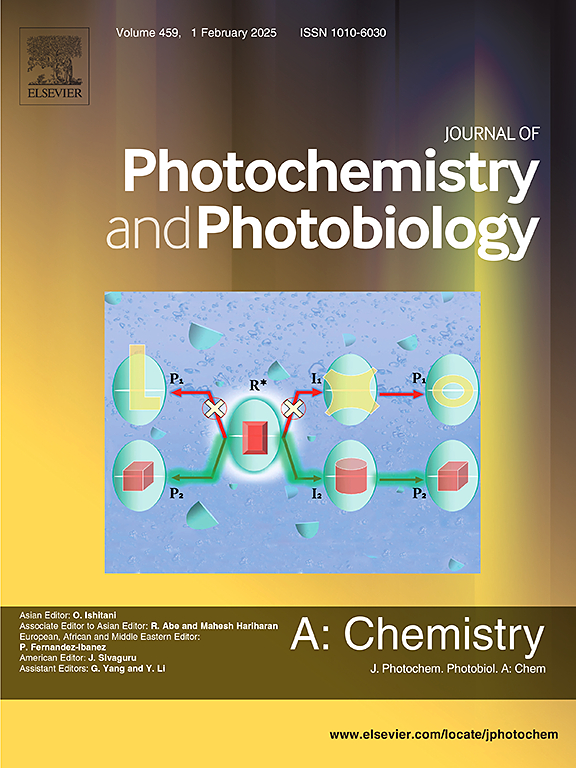Photocurrent enhancement in dye-sensitized solar cells by polyimide covalent organic frameworks decorated with silver nanoparticles
IF 4.1
3区 化学
Q2 CHEMISTRY, PHYSICAL
Journal of Photochemistry and Photobiology A-chemistry
Pub Date : 2024-09-27
DOI:10.1016/j.jphotochem.2024.116052
引用次数: 0
Abstract
Covalent organic framework (COF), featuring in highly ordered conjugated hexagonal array architecture, gains much attention due to their application potential in emerging energy and optoelectronic technologies. Polyimide-based COF (PI-COF) has alkaline-hydrolyzable imide units that can serve as adsorption sites for the anchorage of metallic nanoparticles, particularly eye-catching for multifunctionality. In this study, Ag nanoparticles (Ag NPs) sizing 5 to 20 nm are evenly attached on the surface of spherical PI-COFs through alkaline hydrolysis, ion exchange, and reduction reactions. The Ag-decorated COF (COF@Ag) are doped into the titania photoelectrode of dye-sensitized solar cell (DSSC) to explore its multifunctionality for the photovoltaic performance. The DSSC with the doping of COF@Ag exhibits a power conversion efficiency of 8.03 % under simulated one sun illumination, outperforming that without the doping of COF@Ag (6.86 %) by an enhancement in the photocurrent from 15.14 mA cm−2 to 17.31 mA cm−2. Comprehensive analyses including dye loading, electrochemical impedance, electron kinetics, and light absorption confirms the multifunctionality of COF@Ag. Localized surface plasmon resonance (LSPR) of Ag NPs enhances the photocurrent, and host–guest interaction of COFs facilitates the charge injection and suppresses the charge recombination.

用银纳米粒子装饰的聚酰亚胺共价有机框架增强染料敏化太阳能电池的光电流
共价有机框架(COF)具有高度有序的共轭六方阵列结构,因其在新兴能源和光电技术领域的应用潜力而备受关注。聚酰亚胺基 COF(PI-COF)具有可碱水解的酰亚胺单元,可作为锚定金属纳米粒子的吸附位点,其多功能性尤其引人注目。本研究通过碱性水解、离子交换和还原反应,在球形 PI-COF 表面均匀附着了 5 至 20 nm 大小的银纳米粒子(Ag NPs)。在染料敏化太阳能电池(DSSC)的二氧化钛光电极中掺入Ag装饰的COF(COF@Ag),以探索其光伏性能的多功能性。掺杂了 COF@Ag 的 DSSC 在模拟一太阳光照射下的功率转换效率为 8.03%,高于未掺杂 COF@Ag 的 DSSC(6.86%),光电流从 15.14 mA cm-2 提高到 17.31 mA cm-2。包括染料负载、电化学阻抗、电子动力学和光吸收在内的综合分析证实了 COF@Ag 的多功能性。Ag NPs 的局部表面等离子体共振(LSPR)增强了光电流,COFs 的主客体相互作用促进了电荷注入并抑制了电荷重组。
本文章由计算机程序翻译,如有差异,请以英文原文为准。
求助全文
约1分钟内获得全文
求助全文
来源期刊
CiteScore
7.90
自引率
7.00%
发文量
580
审稿时长
48 days
期刊介绍:
JPPA publishes the results of fundamental studies on all aspects of chemical phenomena induced by interactions between light and molecules/matter of all kinds.
All systems capable of being described at the molecular or integrated multimolecular level are appropriate for the journal. This includes all molecular chemical species as well as biomolecular, supramolecular, polymer and other macromolecular systems, as well as solid state photochemistry. In addition, the journal publishes studies of semiconductor and other photoactive organic and inorganic materials, photocatalysis (organic, inorganic, supramolecular and superconductor).
The scope includes condensed and gas phase photochemistry, as well as synchrotron radiation chemistry. A broad range of processes and techniques in photochemistry are covered such as light induced energy, electron and proton transfer; nonlinear photochemical behavior; mechanistic investigation of photochemical reactions and identification of the products of photochemical reactions; quantum yield determinations and measurements of rate constants for primary and secondary photochemical processes; steady-state and time-resolved emission, ultrafast spectroscopic methods, single molecule spectroscopy, time resolved X-ray diffraction, luminescence microscopy, and scattering spectroscopy applied to photochemistry. Papers in emerging and applied areas such as luminescent sensors, electroluminescence, solar energy conversion, atmospheric photochemistry, environmental remediation, and related photocatalytic chemistry are also welcome.

 求助内容:
求助内容: 应助结果提醒方式:
应助结果提醒方式:


